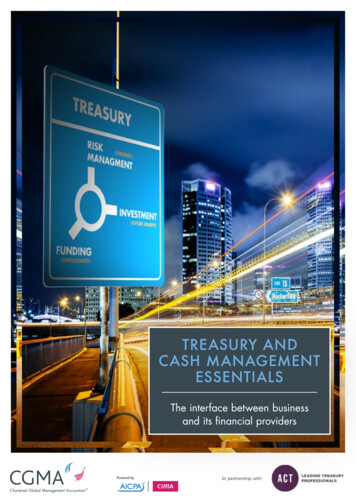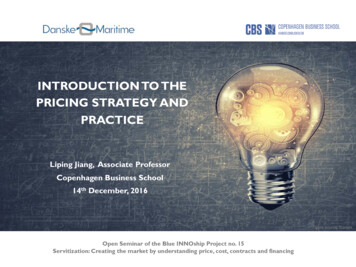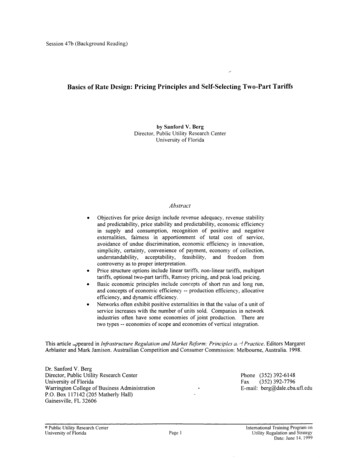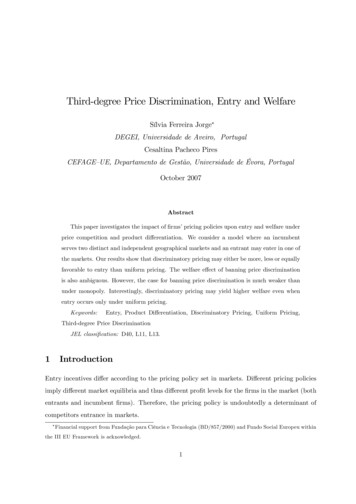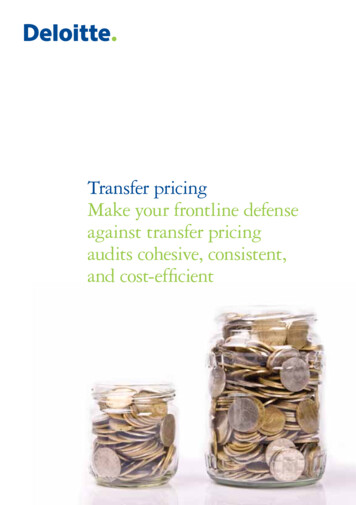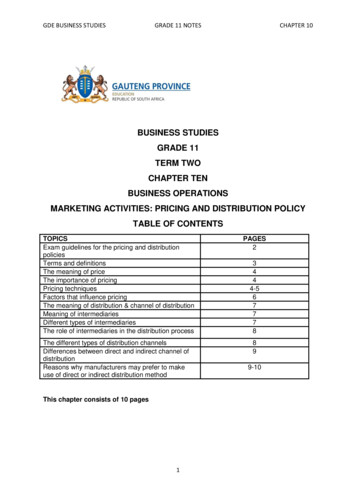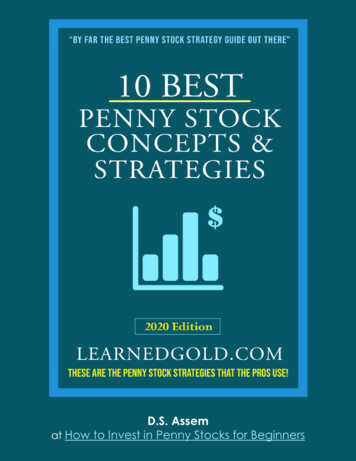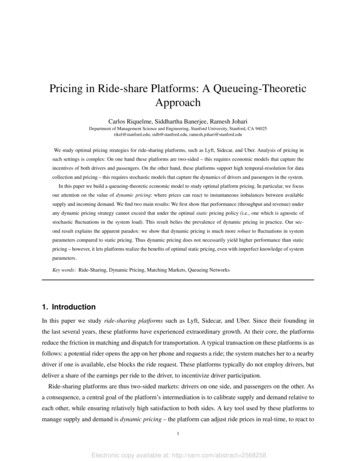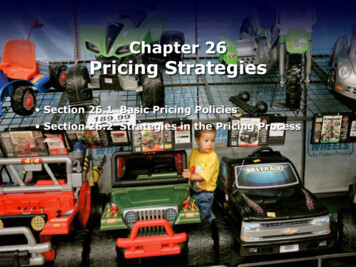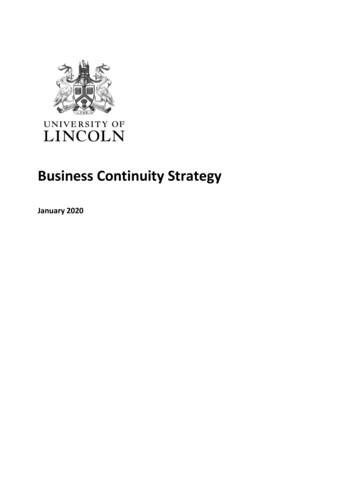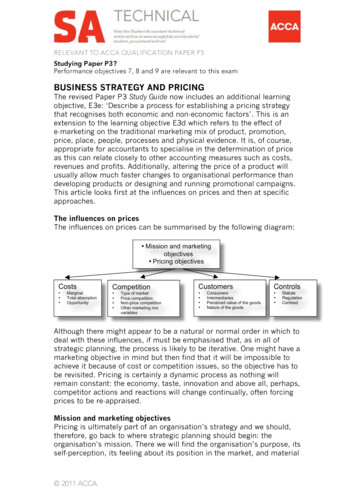
Transcription
RELEVANT TO ACCA QUALIFICATION PAPER P3Studying Paper P3?Performance objectives 7, 8 and 9 are relevant to this examBUSINESS STRATEGY AND PRICINGThe revised Paper P3 Study Guide now includes an additional learningobjective, E3e: ‘Describe a process for establishing a pricing strategythat recognises both economic and non-economic factors’. This is anextension to the learning objective E3d which refers to the effect ofe-marketing on the traditional marketing mix of product, promotion,price, place, people, processes and physical evidence. It is, of course,appropriate for accountants to specialise in the determination of priceas this can relate closely to other accounting measures such as costs,revenues and profits. Additionally, altering the price of a product willusually allow much faster changes to organisational performance thandeveloping products or designing and running promotional campaigns.This article looks first at the influences on prices and then at specificapproaches.The influences on pricesThe influences on prices can be summarised by the following diagram: Mission and marketingobjectives Pricing objectivesCosts MarginalTotal absorptionOpportunityCompetition Type of marketPrice competitionNon-price competitionOther marketing mixvariablesCustomers ConsumersIntermediariesPerceived value of the goodsNature of the goods Controls StatuteRegulationContractAlthough there might appear to be a natural or normal order in which todeal with these influences, if must be emphasised that, as in all ofstrategic planning, the process is likely to be iterative. One might have amarketing objective in mind but then find that it will be impossible toachieve it because of cost or competition issues, so the objective has tobe revisited. Pricing is certainly a dynamic process as nothing willremain constant: the economy, taste, innovation and above all, perhaps,competitor actions and reactions will change continually, often forcingprices to be re-appraised.Mission and marketing objectivesPricing is ultimately part of an organisation’s strategy and we should,therefore, go back to where strategic planning should begin: theorganisation’s mission. There we will find the organisation’s purpose, itsself-perception, its feeling about its position in the market, and material 2011 ACCA
2BUSINESS STRATEGY AND PRICINGFEBRUARY 2011relating to the organisation’s culture and ethics. Pricing cannot beseparated from mission.For example: An organisation might have a charitable or not-for-profit purpose,in which case prices for its products and services might be zero orheavily subsidised. An organisation might perceive itself to be ‘up-market’, in whichcase it might have to charge high prices to project quality andexclusivity. Pharmaceutical companies face ethical issues when pricing theirlife-saving products for both rich markets where they hope tomake profits, and for poor markets where there are ethical andsocial responsibility dimensions.Pricing objectivesWhereas missions and marketing objectives tend to be long term, in theshorter term there can be a variety of pricing objectives. For example,profit-seeking organisations have to at least break even eventually and, ifpossible, prices have to be set to allow this. There is, for example, nopoint in having a mission which is to be upmarket, and then trying toenforce that impression by having prices so high that sales volumes arenegligible. Sometimes, the need to survive and bolster cash flowsquickly will dictate massive price cuts. Sometimes an organisationmight reduce its prices, sustaining losses for a while, in the hope offorcing competitors to withdraw from the market.CostsIn profit-seeking organisations, revenues have to exceed costs; in not-forprofit organisations revenue has to match income. By this stage of yourstudies you should be well aware that any positive contribution (that iswhen marginal revenues exceed marginal costs) helps to cover fixedcosts. To make a profit, revenue has to exceed all costs. What mightbecome more relevant in strategic management is the importance ofopportunity costs and of exit costs.An opportunity cost is the revenue foregone as a result of a decision. Ifyou build on a piece of land you cannot then sell the land for cultivation,for example, and the sale price foregone is an opportunity cost of thedecision to build. Exit costs can arise when trying to abandon a strategy.For example, in some countries large liabilities can be incurred ifemployees are made redundant. Sometimes clean-up or reparationcosts can be triggered if undertakings are closed down. In suchcircumstances, it might be cheaper to carry on provided marginalrevenues just exceed marginal costs. If competitors are in this positionthen we are likely to suffer great price pressure from them. 2011 ACCA
3BUSINESS STRATEGY AND PRICINGFEBRUARY 2011CompetitionThere are four main types of market, each giving rise to a particular typeof competition: Perfect competition. This form of market consists of many smallsuppliers and customers none of which can influence the market.There is free entry and exit from the market and all supplyidentical products. Here, suppliers must charge the market price.They cannot charge more because, as the products are identical,every customer would move to cheaper suppliers; there is nopoint in reducing their prices because all output can be sold atthe market price. It is worth noting that the internet has tended tomake price and competition much more transparent and thatthere are sites which specialise in comparing suppliers’ prices. Oligopoly. This special type of market consists of a small numberof suppliers supplying identical products. An example is found inpetrol companies. If a supplier increases prices, the others simplyhave to maintain theirs to gain market share. If a supplier reducesprices, the others must follow suit to maintain their market share.There is therefore little incentive to reduce prices as competitorswill follow. Monopoly. In a monopoly market there is only one supplier of aproduct. The supplier can charge whatever is wished, thoughdemand is likely to vary as a result. This is the great freedom amonopolist has: choose the price to charge so that profits can bemaximised. Note that despite that statement, being a monopolistdoes not guarantee that a profit is made. You might be the solesupplier of something no one wants. Monopolistic competition. This is a very unhelpful, almostself-contradictory term for the type of market this represents. Thisform of competition means that there are a number of supplierssupplying similar but not identical goods. Essentially, theproducts are being differentiated in some way and, therefore, cancommand different prices. Suppliers are competing, but withdifferent offerings.Price competition means that consumers are motivated primarily byprice and usually suppliers will have to offer low prices to succeed. Veryoften organisations which use a cost leadership strategy adopt pricecompetition. Their products are ordinary, but because their costs arevery low (if not actually the lowest) prices can also be kept down.Many laptop producers use price competition because, for most, theirproducts have been commoditised: they all do the same things, with thesame operating systems, run the same application software and havesimilar reliabilities. 2011 ACCA
4BUSINESS STRATEGY AND PRICINGFEBRUARY 2011Non-price competition means that consumers pay attention not only tothe price of the goods but are also influenced by other marketing mixvariables such as the: quality, brand and features of the goods promotion activities place (where the goods or services are obtained).Essentially, organisations which follow a differentiation or focus strategywill be making use of non-price competition. They seek to make theirproducts different so that they are particularly attractive to consumers,who in turn are willing to pay premium prices. Considering again thelaptop producers mentioned above, we could probably argue that Appleuses non-price competition. Its laptops look different and unique, theyhave a different operating systems and run different (but oftencompatible) software. This can make it difficult to directly compareprices, but many people have the impression that, insofar as it ispossible to compare like with like, Apple machines are more expensivethan others. Nevertheless, they sell well and profitably.ConsumersSuppliers have to keep in mind both what the end consumers are willingto pay and also the profits that will be expected by intermediaries in thesupply chain. Many industries have ‘rules of thumb’ about the mark-upsthey expect to be able to apply. It is common to segment marketsaccording to wealth so that a company will have a ‘value’ range of goodsfor poorer or thriftier customers who might respond to pricecompetition, and a more exclusive range for better-off customers, whomight respond to non-price competition.Even if there are not different lines of goods for different customergroups, it can still be possible to charge different prices for the sameproduct to different groups. This is known as price discrimination. Forexample, it is often cheaper to buy electronic goods in the US than inEurope. Leakage of goods from the cheaper to the more expensivemarket must be prevented in some way, so the groups have to besufficiently separate (or un-informed). The pharmaceutical companyexample given above is another instance of price discrimination wheredrugs are sold at high prices within rich economies and often at muchlower prices elsewhere. Leakage from one market to the other isreduced by giving the products different names (even though they arepharmacologically identical) and by controlling distribution carefullythrough hospitals and government agencies.The perceived value of goods is a concept which is also related tonon-price competition and, indeed, to price. We have all, no doubt, beeninfluenced by the thought that a higher price implies goods of a highervalue even though we are often essentially ignorant about the merit of 2011 ACCA
5BUSINESS STRATEGY AND PRICINGFEBRUARY 2011those goods. For example, when buying a T-shirt there is a very widerange of prices for a range of garments which are very similar looking.We assume that the expensive T-shirt with the fashionable label is‘better’ than the cheaper, more basic lines. However, often we really donot know, and might even be paying for the kudos we feel an exclusivelabel gives us.Whether goods are necessities or luxuries also influences consumers’reactions to prices and price changes. This affects the elasticity ofdemand of the product, which is a measure of how a change in salesvolume is caused by a change in price. Goods that have a high elasticityof demand are very price sensitive and are likely to be luxury productsthat consumers are prepared to do without if the price rises too much.Goods with a low elasticity of demand are relatively unaffected by pricechanges and are likely to be necessities. As prices rise, demand will stayhigh because customers need the goods. Note that not all goods areregarded the same way by customers. Some consumers might regard aforeign holiday as the highlight of their year and sacrifice otherconsumption so that they can afford higher air fares. Other consumershave little interest in going abroad so would immediately react to priceincreases.ControlsSome industries are closely regulated by statute and regulation, andthey have little power to choose their own prices. Other industries areable to, or try to, dictate final prices charged to consumers. Forexample, exclusive perfume and cosmetic producers resist pricecompetition by insisting in their supply contracts that their retailers donot discount their products. Note that not all contractual arrangementsare legal. Pricing cartels (competitors fixing prices) are frowned upon bymost governments.Setting pricesNow that we have looked at what can influence prices, we can considerhow to set prices. Once again we must refer back to the organisation’smission and objectives as it cannot set prices without reference to itslonger term ambitions. In an ideal world, organisations would have fullinformation about: Customers – what would they pay and what is the likely demand? Competitors – what are their products, what are their prices andhow do they compete? The resultant costs, revenues and profits arising from a specificprice.In practice, determining much of this information can be difficult, andagain it is worth emphasising that markets are often very volatile andprices might need to be reviewed and changed frequently. Note that 2011 ACCA
6BUSINESS STRATEGY AND PRICINGFEBRUARY 2011‘price’ includes not just the price level itself, but also the use ofdiscounts (particularly important in business to business sales), andpayment terms.The methods of setting prices include the following.Setting prices to maximise profitsIn theory, and as you might recall from earlier studies, profits aremaximised when:Marginal cost Marginal revenueIn practice, this is almost useless advice to most organisations.Although we might expect a well-controlled organisation to havereasonable information about how its costs move, very few will havesufficiently detailed or stable information about how revenues move, asthey are affected by fickle consumers, competitor action and economicconfidence.Setting prices to break evenThe break-even volume is given by:Fixed costs/(Selling price per unit – Variable cost per unit)orFixed costs/Contribution per unitSetting a high selling price per unit will generate a high contribution perunit and this would require a smaller volume to be sold beforebreakeven point is reached. The company could, therefore, evaluatevarious options of prices and volume and compare these to what it feelscustomers might find attractive and what competitors might becharging.Cost-based pricingHere the cost per unit is determined (either total absorption cost,marginal cost or relevant costs) and a set amount, or a set percentage,is added to that to give the selling price. If the forecast volume is sold atthe price set, then the forecast profit would be made. However, althoughuseful as a guideline, the method is not sufficient because it is entirelyinward looking and pays no heed to competitors or customers. Theresulting prices must always be looked at with some scepticism, and theorganisation must assess how those fit in with the market. An inability tomake a reasonable margin on sales must indicate that either costs aretoo high or demand for the product is too weak. Strategically speakingthe organisation would be ‘stuck in the middle’. 2011 ACCA
7BUSINESS STRATEGY AND PRICINGFEBRUARY 2011Competition-based pricingBy contrast, this approach is entirely outward-looking. It strives tomatch what competitors are charging and is the only option when inperfect competition. Goods should sell at that price, but there is noguarantee that sufficient profit will be made. This approach, therefore,places high importance on being able to achieve low costs, ideally costleadership.Marketing-orientated pricingIn this approach, the organisation attempts to escape from theconstraints of perfect competition and sells a product differentiated byfeatures, quality, design, promotion, place and so on. Generally, higherprices are sought and are justified by products better matching amarket segment’s needs. For example, consider a company whichmakes agricultural chemicals. In general, farmers will need to buy thesein spring, but will get no income from their crops until harvest in theautumn, so farmers have a very adverse cash flow for around sixmonths. Think how attractive it might be if the manufacturer gavefarmers payment terms of six months to match their cash flow needs.The prices of the chemicals might be higher than those of competitors,but the convenience to farmers plus the apparent empathy shown withtheir problems could well outweigh the price differences.Strategic approachesIt is important to note several ways in which price can be used withmore strategic intent, here using the term ‘strategy’ to mean a ‘ploy’. Price skimming. This approach is often seen when new technologyis introduced. There are some consumers who will pay a very highprice for new products, perhaps because they need them orperhaps because they have more money than sense. After themost desperate, the richest or the most profligate consumershave been satisfied, the price is reduced to skim off another layer.At some stage a longer-term stable price is reached. Penetration pricing. Here, the ambition it to use a very low priceto capture a very high market share. Note that this very highmarket share could well give economies of scale that will allowlow costs and hence low prices to be maintained in the long term.In fact, a large market share can be a barrier to entry as smallernew suppliers will have to match, what are to them, uneconomiclow prices. Product-line pricing. Car manufacturers, for example, offer rangesof the same model of car. This enables them to attract customersby advertising ‘Prices from 10,000 ’, and then often topersuade the customer to move up the range. You can be surethat the additional price on upmarket models will be muchgreater than the additional costs incurred making them. 2011 ACCA
8BUSINESS STRATEGY AND PRICINGFEBRUARY 2011 Related product pricing. We have probably all experienced thiswith inkjet printers. Many of these sell for about 100, and whenyou come to renew the ink cartridges you have to pay about 80.Here the organisation makes most of its profits on after salesservices that consumers feel committed to after the initialpurchase.Demand manipulation. This is frequently seen in train ticket andairline prices. Not only are the companies using pricediscrimination (charging business travellers more for peak-timetravel) but they are also encouraging others to make use of theservices at other, less crowded times. Another example can beseen in heating engineering businesses which can have a problemmeeting demand in winter but have idle staff over summer. Theycould even-out demand (and lower their costs) by offering routineservicing over summer at a discount, or for which payment didnot have to be made until much later.Summary Pricing is part of the marketing mix of both products and servicesand it can be changed very quickly. After the marketing and pricing objectives have been decided,pricing has to then consider costs, competition, customers andcontrols. In the long-run, prices must at least match all costs if profits areto be made, but sometimes exceeding marginal costs andrelevant costs will be sufficient. Competition can be based on price or can be non-pricecompetition. In non-price competition the company is in someway differentiating its products or services so that price is not theonly factor influencing purchasing decisions. Consumers will react to prices and price changes. For example,luxury goods are likely to be more sensitive to price changes thannecessities. Price discrimination can allow different prices to becharged for the same product in different markets. Controls over prices can be set by governments and regulators. The calculation of the selling price can be based on variousapproaches (such as cost plus). However, unless a company isvery lucky, it is unlikely to have full information about the demandthat will be generated by any price and a ‘reality check’ is needed. There are a number of strategic approaches to pricing such asprice-skimming, related product pricing and demandmanipulation.Ken Garrett is a freelance lecturer and writer 2011 ACCA
BUSINESS STRATEGY AND PRICING The revised Paper P3 Study Guide now includes an additional learning objective, E3e: 'Describe a process for establishing a pricing strategy that recognises both economic and non-economic factors'. This is an extension to the learning objective E3d which refers to the effect of
